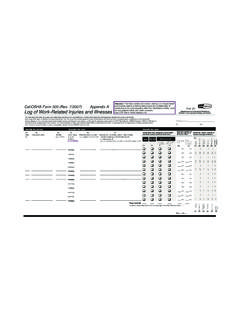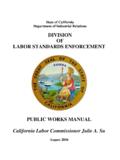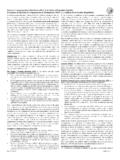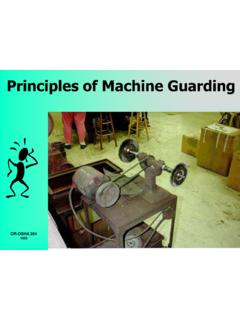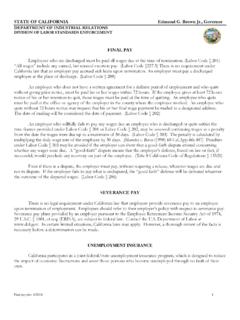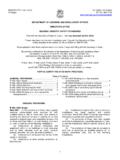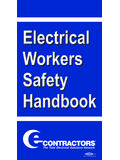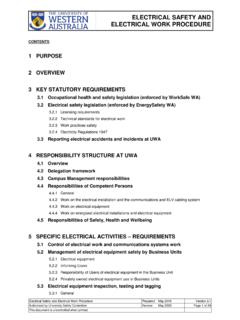Transcription of Cal/OSHA Guide to Electrical Safety
1 Cal/OSHA Guide to Electrical Safety Cal/OSHA Consultation Service Research and Education Division of Occupational Safety and Health This Guide is not meant to be either a substitute for or a le gal interpretation of the occupational Safety and health regulations. Readers shall refer directly to Title 8 of the California C ode of Regulations and the Labor Code for detaile d information regarding the regulation s scope, specifications, and exceptions and fo r other requirements that may be applicable to t heir operations. Rev ised: October 20 12 Pr oduced by the State of California Department of Industrial Relations Ca l/O SHA C onsu ltation Serv ice Ca l/O SHA safe ty and health publications are available at You may also ca ll Cal/OSHA C onsu ltation S ervice off ices list ed on the back cove r of th is Guide for info rmation on how to get Cal/O SHA public ations.
2 1 Cal/OSHA Guide to Electrical Safety Why i s el ectrical Safety so important? Workers such as electricians, apprentices, power line workers, and other groups of employees work directly with electricity and may be exposed to dangerous conditions if adequate precautions are not taken. Workers are injured or killed every year in California due to occupational accidents involving uncontrolled exposure to electricity. When shortcuts are taken and safe procedures are not followed, loss of life, permanent disfigurement, lost work time, increased workers compensation costs, and lawsuits can occur. As per the Bureau of Labor Statistics, 163 workers died from injuries from c ontact with electric c urrent in 2010. 76 workers died from over head power li nes in the same year. Source: US Departm ent of Labor, Bureau of Labor Stati st ics Fatal occupational injuries by event or ex posure, 2009-2010 A worker was electrocuted from accidental contact with an over head power li ne.
3 The victim wa s carrying a metal ladder upright to his work van. The foreman and several of his co-workers observed and ver bally war ned him about the overhead power li ne. However, several s econds later, the victim s lad der made contact with the overhead power li ne and the victim fe ll to the ground suffering fatal injuries. Th is booklet explains some of the most common Electrical hazards and measures the law requires employers and employees to ta ke in order to provide a safe and healthful workplace. Common Electrical hazards With all Electrical equipment opera tions, ther e is t he threat of shock and/or electrocution. Electrical workers are potentially ex posed to a variety of hazard s such as electric s hock (the most common hazard), arc flashes, fa lls, an d therm al burns. When you receive an electric shock, an electric current runs through your body because the body has become a conductor for electricity.
4 Electrocution occurs when enough current flows through your body to cease the functions of vital organs and causes burns to muscular and skin tissues. The following are samples of the most common Electrical s afe ty related hazards t hat will pose a risk of being shocked and/or electrocuted. 2 Ex posed wires and energized par ts Fault y/broken wiring or equipment Damaged outlets and missing covers Worn/damaged electrica l c or ds Imp roper ly used extension cords Overloaded outl ets No warning signs Working under wet conditions Lack of or i nsuff icient protective dev ices Unrestrict ed access to live exposed par ts Lack of or i nsuff icient personal protective equipment (PPE) Insuffici ent clearances around panels Lack of/i mpr oper lockout/ta gout procedures Fa ilure to maintain p roper cleara nce fro m over head lin es Fa ilure to fo llow manufacturer s instruction when using electrically powered equipment.
5 Where can I find the Cal/OSHA regulations for Electrical Safety ? Ca l/O SHA regulations on Electrical s afe ty require Californ ia employers to provide workers with a safe and healthfu l workplace. These regulations are contained in Title 8 o f the California Code of Regulations (T8 CCR). Most of the Electrical health and Safety regulations can be found in T8 CCR, C hapter 4, Subchapte r 5 in the Electrical Safe ty Or ders, Sections 2299 through 2989 (http:/ ). Ca l/O SHA regulations on Electrical s afe ty ar e grouped by Electrical v oltage. Regulations f or lo w vo ltage (0-600V) are given in Sections 2299-2599 and the regulations for high vo ltage (above 600V) are given in Sections 2700-2989. Sectio n 1518 addresses the safe ty requirements f or t he protection of yourself and others from electric s hock in construction. Sectio n 1541 addresses Electrical s afe ty requirements f or e xcavation wor ks i ncluding subsurface i nsta lla tions.
6 What can you do to protect yourself and others fro m el ectrical hazards? Employees can prevent shocks and injuries/electrocution from Electrical hazards by: Understanding electric shock and electrocution Recognizing pot enti al hazards around work involving electricity Fo llowing Cal/O SHA requirements Maintaining cleara nces around panels Using proper protective devices Elimi nati ng access to exposed energized par ts 3 Using proper PPE Using proper lockout/tag out procedures Maintaining proper clear ance from over head lin es Fo llowing proper procedures for confined space/enclosed space /u nderground Electrical work Fo llowing manufacturer s instructions Fo llowing safe work practic es Understanding electric shock and electrocution It is important to understand that shock c an occu r even without physically contacting live Electrical parts when there is enough voltage.
7 It is t he ra te of current flowing thr ough the body , more than anything else, which determines how severe the shock will be. Effects on the body could r ang e from a mi nor sho ck to paralysis of vital organs such as the lungs and heart. Ho w severely the body is a ffected by electric s hock dep ends on: 1. The rate of flow of the current through your body The rate of current flow (measured in amperes) depends on how good of a conductor of electricity the human body can be. If y ou have dry hands and are standing on a nonconductive surface such as a rubber mat, your body will not be a good conductor and you may not even feel t he shock. However, if you have wet hands, are perspiring or standing in water, your body will become a g ood conductor and you may get a severe shock or be killed. 2. The length of time the current flows through your body If the shock c auses you to stay attached to t he Electrical equipment, you could receive severe internal injury.
8 The long er the employee stays in contact, the longer the exposure to the current flow, and hence the more severe the shock. 3. The path the c urre nt takes through your body The most dangerous paths through the body are those where the current g oes thr ough vital organs. For example, current wh ich r uns f rom hand to hand, hand to head, or foot to hand (or head ) and passes through vital org ans can cause severe internal damage to vital organs such as th e heart and l ungs. Recognizing potential hazards around work involving electricity Electrical workers need to recognize/identify all of the pot enti al hazards i nvolving their work. They need to know that the chances of being electrocuted go up when working: with high voltage , ar ound water, while sweati ng, and without w earing/using pr oper protective clothing. Before the work begins, it is important to identify and recognize if any of the hazardous conditions exist (incl uding those list ed a bove under Common Electrical hazards ).
9 You can t ake precaut ionary measures against the hazard only when you know about it. Foll owing Cal/OSHA requirements Fo llowing all of the requirements of Ca l/O SHA including those from the Electrical 4 Safe ty Or ders and Construction Safety Or ders helps you in ke eping the workplace safe and accident/i njuriy free. Because of the danger of electric s hock, Cal/OSHA regulations specify that only q ualifi ed employees can work on Electrical equipment or systems. A few of the most common Cal/O SHA requirements are briefly su mmarized below: No wor k is to be done on expose d, energized parts of equipment or s ystems until: A responsible and qualified supervisor has determined that the work is to be do ne wh ile the part or s ystem is energ iz ed Workers have been t rained in th e hazards i nvolved and the specific techniques in their j ob Personal protective equipment (incl uding insulating gloves and eye protection) has been issued Necessary barriers, barric ades, tags or warning signs are in place You also need to always assume that circu its are energized unless you have locked them out and tested them to ensure they are de- ene rgiz ed.
10 23 When the work has been completed, the supervisor is responsible for ensuring tha t a ll perm anent barr iers and covers ar e reinstalled. Before begi nning construction work, the employer needs to kno w whet her any par t of an energ ized electric power ci rcu it could make contact with employees or equipment. Employers must put legible markings and post warning signs as Maintaining clearances around electric panels Make sure there is s uffici ent cleara nce to operate and service Electrical equipment safely. The chance that a worker may be shocked increases when he or she works on equipment with ene rgized and exposed parts in a cramped space. Because of the danger posed to workers who work in cramped spaces, Cal/O SHA has established regulations setting minimum clearances ar ound Electrical equipment rated at 600 vo lts or l ess.
